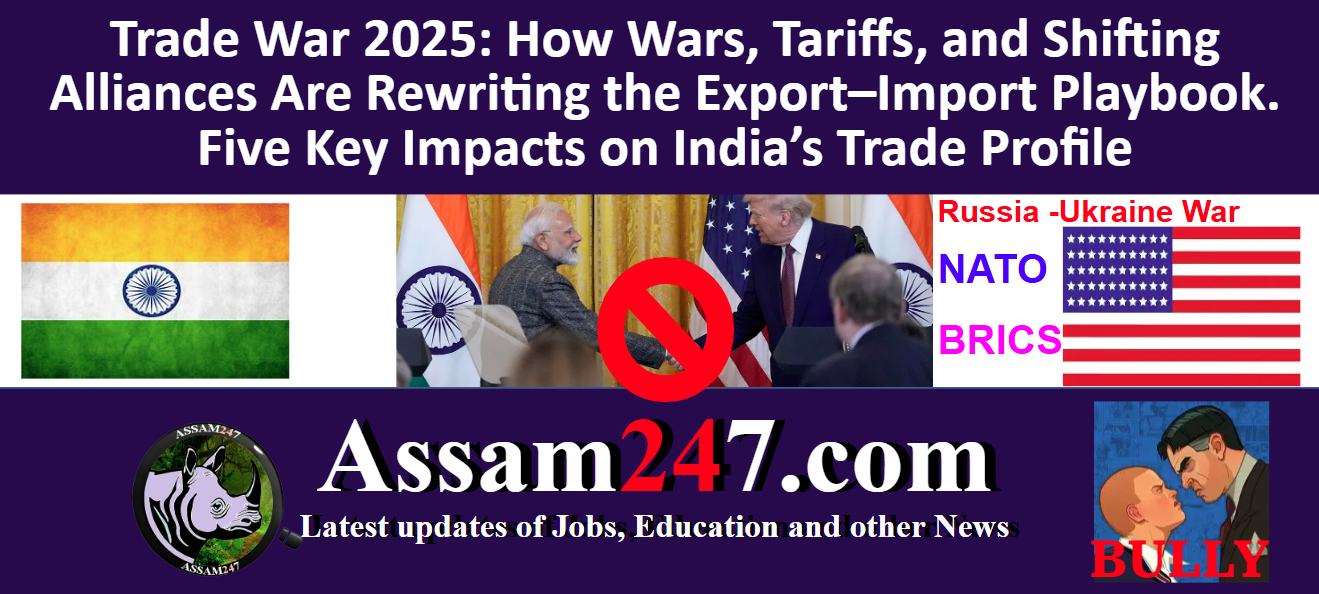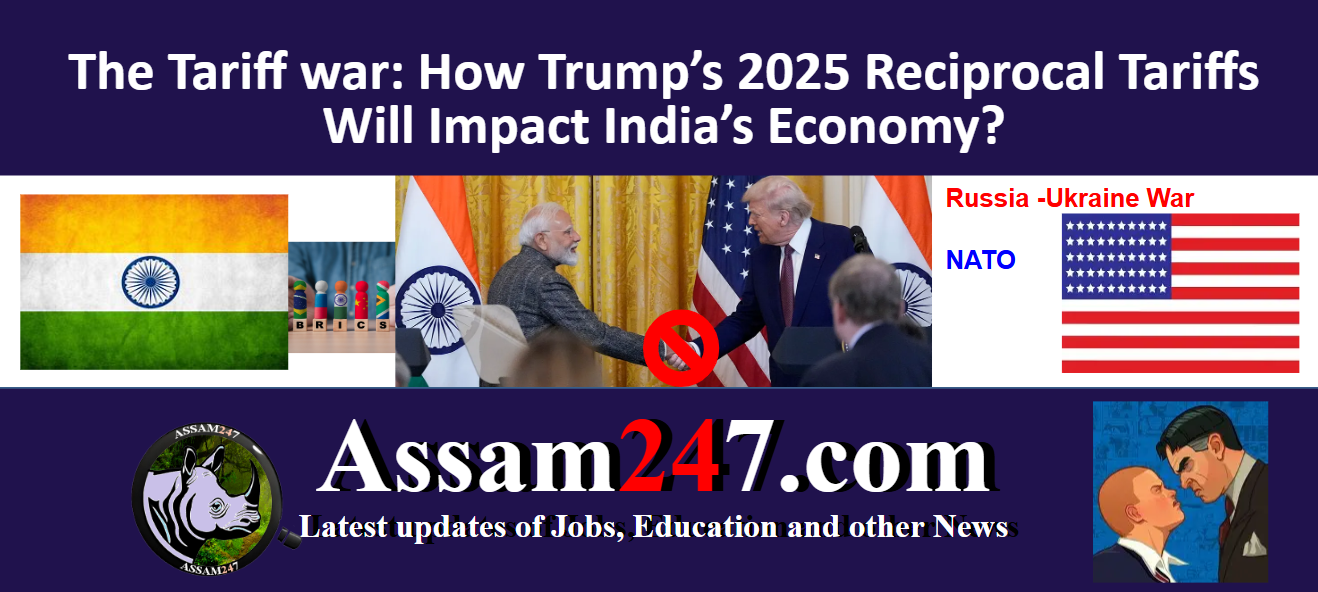Introduction
2025 isn’t just another year for global trade—it’s a storm. Between the escalating trade war, the Russia–Ukraine conflict, the Israel–Iran confrontation, and President Trump’s tariff blitz, India’s import–export landscape is being reshaped almost daily.
While some sectors are thriving as supply chains shift, others are buckling under the pressure of rising costs, volatile markets, and geopolitical risk. Let’s unpack India’s top exports, imports, and the global forces pushing them into uncharted waters.
India’s Top Exports: Winners in a Turbulent World
Despite the global turbulence, several Indian export sectors are emerging stronger than ever:
- Refined Petroleum Oils (~$70.3B)
Cheap Russian crude—acquired amid Western sanctions—has fueled India’s refining boom. With global supply chains disrupted, India’s refined petroleum products are in high demand, making this its top export by value. - Smartphones & Telecommunication Equipment (~$22.1B)
Trade war-driven component shortages are pushing global electronics makers to diversify beyond China. India’s expanding assembly plants are stepping in to fill the gap. - Pharmaceutical Preparations (~$20.9B)
As health security becomes a geopolitical priority, countries are increasingly turning to India for reliable, affordable medicines. - Uncut Diamonds (~$14.4B)
Alternative trade routes and renegotiated duties are helping Indian diamond exporters maintain their global edge, even in protectionist markets. - Jewellery (~$12.3B)
Despite economic headwinds, global buyers still seek Indian craftsmanship for its quality and cultural cachet. - Rice (~$11.8B)
Food security concerns have kept global demand steady, making rice a dependable foreign exchange earner. - Auto Parts (~$7.5B) & Cars (~$7.0B)
As tariffs disrupt traditional auto supply chains, India is emerging as a reliable exporter of both vehicles and components. - Aerospace Exports (~$6.0B)
The post-pandemic rebound in air travel and defense procurement is boosting India’s civil and defense aerospace exports. - Speciality Chemicals (~$5.4B)
From pharma intermediates to high-value industrial chemicals, these exports remain resilient despite trade war turbulence.
India’s Top Imports: Strategic Vulnerabilities Exposed
India’s import bill reveals where the country is most exposed to geopolitical shocks:
- Mineral Fuels (Crude Oil, LNG, Coal) (~$220.6B)
- Crude oil: $143B
- LNG: $30B
- Coal: ~$32B
Global oil markets have been roiled by both the Russia–Ukraine war and Israel–Iran tensions. The Strait of Hormuz—through which 20% of the world’s oil passes—is under threat, risking price spikes well above $100–150 per barrel.
- Electrical Machinery & Equipment (~$84.9B)
Despite “Make in India” initiatives, the country remains dependent on imported semiconductors and critical components, particularly from East Asia. - Gems & Precious Metals (~$83.3B)
Gold imports act as a hedge in uncertain times but also strain the trade balance amid price volatility. - Machinery & Computers (~$61.6B)
Industrial upgrades require high-value machinery imports, many from economies affected by the trade war. - Organic Chemicals (~$26.0B)
Key for pharmaceutical and agricultural industries, these imports are vulnerable to global supply disruptions. - Plastics (~$21.9B), Iron & Steel (~$17.7B), Edible Oils (~$17.0B), Optical Equipment (~$13.7B), Aerospace Imports (~$12.6B)
These categories highlight India’s dependence on global suppliers for both industrial and consumer needs.
Global Geopolitical Pressures Shaping India’s Trade
1. Russia–Ukraine War: A Double-Edged Sword
- Benefit: Access to discounted Russian crude has supercharged petroleum exports, adding ~$30B in export value in FY 2022–23 alone.
- Risk: Heavy reliance on one source creates long-term vulnerability. Sanctions or shipping disruptions could cost India ~$5B annually in extra import costs.
2. Israel–Iran Conflict: Energy and Export Disruptions
- The conflict has destabilized oil markets and threatens the Strait of Hormuz, a vital chokepoint for India’s crude supplies.
- Indian basmati rice exporters to Iran face 8-month payment delays and soaring insurance costs—opening the door for Pakistani competitors.
3. Trump’s 2025 Tariffs: A New Trade War Front
- In August 2025, the U.S. doubled tariffs on Indian goods to 50%, citing India’s continued Russian oil imports.
- The move has been condemned domestically as an “economic embargo,” with agriculture and textiles among the hardest-hit sectors.
- Analysts urge India to diversify export markets, strengthen domestic manufacturing, and maintain strategic autonomy in foreign policy.
Trade War 2025: Five Key Impacts on India’s Trade Profile
- Shifting Supply Chains
Export opportunities are rising as India replaces disrupted suppliers in petroleum, electronics, and pharma. - Energy Vulnerability
A $220B+ energy import bill remains the country’s most exposed trade risk. - Manufacturing Pushback
Tariffs on Chinese goods are encouraging local production, but dependence on imported components slows progress. - Commodity Realignments
Trade sanctions and tariff barriers are forcing India to find new sources for metals, oil, and agricultural inputs. - Pharma’s Strategic Rise
India’s $20.9B pharmaceutical industry is positioned as a key player in global health security.
Conclusion: Navigating the Trade Storm
India’s trade story in 2025 is one of resilience under fire. Petroleum, electronics, pharma, and rice are gaining ground globally, while heavy reliance on imported energy and machinery remains a critical weakness.
Wars in Europe and the Middle East, coupled with U.S. tariff aggression, are forcing India to adapt—fast. The path forward lies in:
- Diversifying energy sources
- Strengthening domestic manufacturing
- Building alternative trade alliances
- Expanding high-value exports
In a world where trade corridors can close overnight and tariffs can double in a tweet, India’s ability to adapt will determine whether it emerges from this storm stronger—or simply weathered.





